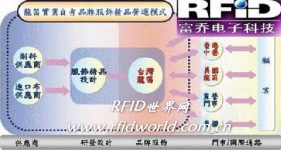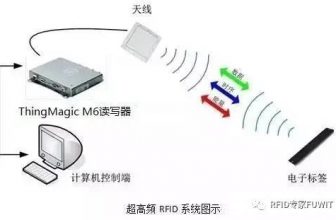
Application solution of RFID smart electronic tag in the clothing industry
[ad_1]
A chip is implanted in the clothing tag. This chip has a unique 64-digit ID code in the world. There is also an integrated circuit in the tag, which establishes a unique correspondence between the ID code and the information in the tag. Each tag has a corresponding display. The fake tag has no corresponding display. When checking, if it is data outside the database, it is a completely illegal fake tag.

At the same time, the use of RFID technology for clothing identification will also improve inspection efficiency and realize the collaboration, transparency and visualization of supply chain management through RFID. According to our company’s understanding, this new technology is still new in China. We use this advanced technology to automate the management of inventory, transportation, and sales processes in the apparel industry.
RFID electronic clothing tag is embedded with a smart “core” in the middle of the paper layer. It has the characteristics of direct surface printing, strong anti-counterfeiting ability, reliable inspection and accurate background statistics. Secondly, because it is embedded with a chip with the only code in the world. , The clothing tag can be verified with a handheld reader, which is extremely efficient, with a reading and writing rate of 0.3 seconds per time, and completely solves the phenomenon of one card with multiple uses. In addition, the clothing tag system is all computers connected to the Internet, which effectively solves the problems of statistics, heavy workload, and high error rate.
1. Features and advantages of RFID smart electronic tags
The types of RFID products continue to be enriched. Active electronic tags, passive electronic tags and semi-passive electronic tags have all been developed. The cost of electronic tags has been continuously reduced, and the scale of applications has expanded rapidly. Compared with other automatic identification technology products, RFID has the following advantages:
1.1 Large data storage capacity: Among other automatic identification technology varieties, the two-dimensional bar code with the largest data capacity can only store up to 2725 numbers. If it contains letters, the storage capacity will be even less. The storage capacity of RFID tags is more than 2 to the 94th power (nearly 10,000 characters), which completely abandons the limitations of bar codes and makes every object in the world different. Have a unique identifier.
1.2 Fast reading and writing speed: It adopts non-contact mode and no directionality requirement. Once the tag enters the magnetic field, the reader can read the information in it instantly, usually completing a reading and writing within a few milliseconds. The anti-collision mechanism adopted enables it to process multiple tags at the same time to realize batch recognition. The maximum simultaneous recognition can reach so many per second, and it can be recognized in motion.

1.3 High data security: RFID is a unique identification internal code that is fixed in the chip before leaving the factory in accordance with the internationally unified electronic product code encoding system and does not repeat 4o bits. It cannot be copied or changed. This technology is difficult to be counterfeited or invaded, and it is safer to use domestic chips.
1.4 Superior physical performance: It can store permanent data and non-permanent data. The information in the rewritable memory can be changed freely. The data can be dynamically updated, used repeatedly (erased and written 10,000 times, read unlimited), has a long service life (10 years or 100,000 reads and writes), resistant to high and low temperatures, and can adapt to various working environments and working conditions, especially suitable for oil pollution , Dust, radiation and other harsh environments.
1.5 Convenient reading and writing: Data reading does not require a light source, and can even be carried out through the outer packaging, passive long-distance reading and writing. The farthest reading and writing distance can reach 1.5m. When the active tag with its own battery is used, the effective identification distance can reach more than 30m.
1.6 Anti-collision: There is a fast anti-collision mechanism in the electronic tag, which can prevent data interference between cards. Therefore, the reader can “simultaneously” process multiple non-contact radio frequency cards, which can process more than 200 at a time, without a light source, and can even read data through external materials.
Textile, printing and dyeing, and clothing companies use RFID to achieve collaboration, transparency, and visualization of supply chain management, and use electronic tags to achieve warehouse management automation.
Second, the problems that can be solved by the automation of electronic label warehouse management
1. Multi-database collaborative operation: For the needs of circulation, the products of garment industry enterprises are often distributed in different warehouses in various places, so as to transfer goods, allocate goods, and replenish goods. There are also many types of warehouses, such as: finished product warehouse, raw material warehouse, circulation warehouse, turnover warehouse, scattered small warehouses, etc. The inventory of each warehouse needs to be monitored daily to ensure timely supply. Through warehouse management automation, the inventory of each warehouse can be checked at any time, so that the logistics process of products can be tracked in time.
2. Warehouse receipt, delivery, and inventory operations: The most important task in warehouse management is to ensure that the booked quantity is consistent with the actual quantity. The use of electronic tags can easily achieve the accuracy of the goods receipt record and the delivery and distribution of goods. The automation of the inventory, so that there will be no omissions or loss of inventory.

3. First-in, first-out: Each product has a lifespan. Due to the many types of products, it is difficult to ensure accurate first-in, first-out products through manual records and custodian records in actual warehouse management. Through the single tracking technology, a clock can be built in for each product, and the intact state of each product can also be recorded, so that the goods can be shipped out of the warehouse within the specified time limit.
4. Out-of-stock alarm: When a certain product is short in any warehouse, it can not only automatically alert the alarm, but also subdivide into details of product composition such as model type, color, and size. That is, if a certain size of a certain style is broken, the custodian can immediately be reminded to replenish the goods in time.
5. Statistics of unsalable products: The backlog of products in the clothing industry is a very headache. Through the statistics of unsalable products, the residence time of each product (subdivided into models, colors, and sizes) can be obtained, and which products can be quickly discovered Slow sales and out-of-season can easily provide price reduction decisions or exchanges to accelerate product sales and capital turnover.
Three, use electronic tags to achieve sales automation
Clothing products are a kind of fashion products. Many factors such as the season of sale, the location of the sale, the taste of consumers, the fashion trend, the price of the product, and many other factors will affect the sales of the product. Therefore, real-time tracking of sales status is a very important management content for apparel companies.Problems that electronic label sales automation can solve

1. Sales statistics: The statistics of daily sales reports are very important to the sales department of an enterprise. It requires accurate results as quickly as possible. Sales statistics include: statistics by style, color, location, size, etc., which can help the sales department allocate and replenish goods in time.
2. Counter sales automation: The use of electronic tags can realize the functions of the portable POS machine in the monopoly counter, and can complete the sales, return, counter inventory, inventory, collection and other sales automation functions; at the same time, it can generate various statistical reports on the day , And send it to the headquarters or local office for sales analysis.
3. Analysis of broken code sales: different products sell well in different locations, and the demand for different sizes will not be the same. It is necessary to replenish goods in time when the code is broken. Sales statistics and analysis can be used to increase the possibility of code breaks that are expected to occur so that timely replenishment can be notified.
4. Allocation between counters: Sales conditions are different between different locations. Allocation between different counters can speed up the circulation of products and maximize the number of sales. Some varieties are not easy to sell on certain counters, but if you change a location (or a counter), it will become a good selling variety. This can effectively reduce the number of unsalable varieties on the counter.
5. Return control: In the market competition, all manufacturers are improving the quality of service and allowing customers to return goods. Through statistical analysis of returned goods, product quality problems can be accurately identified, and the responsible department, responsible unit and responsible person can be held accountable.
6. Counter inventory and finding goods: Counter inventory and finding goods is a very tedious and error-prone task for each specialty counter. The use of handheld readers or data collectors can easily achieve counter inventory and find goods, improve work efficiency, and will not cause any inventory errors (especially after using a single unique encoding method), and the inventory results can be quickly sent to the superior unit.
7. Shopping mall reconciliation: Generally, the goods sold in the specialty counters are collected by the mall uniformly, so reconciling and collecting money with the mall is a headache for corporate accountants every month. Using the sales automation system, the daily sales records in the data collector are automatically corresponded to the various accounts of the shopping mall, so that the reconciliation work is clear at a glance.
8. Dynamic statistics of best-selling products and favored products: According to the degree of attention and favorability of a certain product by all customers, real-time tracking is carried out according to the sales status, and mathematical models can be established to analyze consumer preferences to better sell.
RFID smart electronic clothing tag is the “identity card” of brand clothing. A clothing tag with a unique code for each piece of clothing is like everyone has an ID card. People who have an ID card are easy to manage, and clothing has RFID smart electronics. Apparel tags also have automated multi-link item management. With the continuous development of domestic technology of RFID smart electronic tags, the application of RFID smart electronic tags has been continuously promoted, and the cost of producing electronic tags has been continuously reduced. RFID smart electronic tags will develop rapidly!
Guangzhou Fuqiao Electronic Technology Co., Ltd.
[ad_2]






